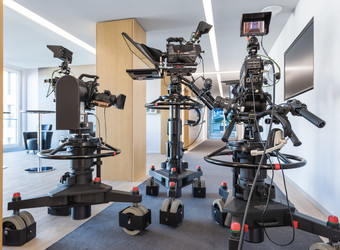Video conferences or discussions via chat are commonplace in many companies. The technological possibilities open up many opportunities – employees can sometimes work from home or even in another city entirely.
However, virtual communication also carries risks: Nonverbal information that we would otherwise subconsciously perceive in face-to-face contact is lost. Misunderstandings and conflicts arise.
We asked our communications expert Dr. Uwe Malinowski what you need to consider if you want to communicate clearly and understandably despite physical distance. Here are his best practical tips.
Tip 1: Effective Communication in Virtual Meetings
Dr. Malinowski, how do I manage conversations in virtual meetings so that they are clear and binding?
First of all, the same rules and tips apply to meetings where participants are in different locations as in a "normal" meeting where everyone is in one room.
However, in communication, we unconsciously react to many small signals, such as facial expressions, gestures, or changes in posture. These are difficult to capture in a "virtual" meeting. This means, for example, that we need to specifically ask for perspectives, opinions, agreement, or disagreement much more frequently. This requires experience and practice so that this doesn't degenerate into a mechanistic method, but is experienced by all participants as authentic and productive.
Tip 2: Avoiding Conflict through Listening
What do I need to consider to avoid misunderstandings? And: What's the best way to resolve conflicts?
It's impossible to avoid misunderstandings in communication. Due to different backgrounds, experiences, attitudes, and perhaps even cultures, statements are never understood exactly as intended. The trick is to recognize misunderstandings quickly enough to avoid conflicts. "Active listening" is a proven method for quickly establishing a shared understanding. This first requires the attitude of truly wanting to understand the other person. In addition, listening, asking good and targeted questions, and paraphrasing are important tools.
Tip 3: Openness is the key to success
Is there an opportunity for small talk in virtual teams? How can I foster interpersonal relationships?
Small talk and interpersonal interaction are not only possible, but actually urgently necessary. Building a relationship is a prerequisite for good communication and collaboration. Team members working together in one location meet in the coffee shop, the cafeteria, or chat across desks. These channels are no longer available in distributed teams and must be consciously replaced.
To achieve this, it is helpful to initiate and allow for a personal introduction right from the start of the collaboration. There are various ways to do this, but the most important part is the leadership setting an example: When you share something about yourself, you set an example for everyone else.
Time for personal conversations must be planned in every meeting. How much time is necessary and appropriate for this depends on the cultures involved: In Germany, for example, it takes less time than in the USA.
Tip 4: Opportunities and Limitations of Virtual Meetings
Will virtual meetings replace traditional meetings in event spaces in the future?
There are various factors driving this trend. These include the increasing globalization of work as well as modern working models with more home offices and the freedom to choose where to work.
As tools become increasingly better, the temptation to forgo traditional meetings is also growing. However, it is often ignored that there is no equivalent to a face-to-face meeting. Any technical support is merely an attempt to mitigate the disadvantages of virtual meetings.
Tip 5: How to Make Virtual Meetings Successful
Are there specific spatial requirements or video etiquette that should be observed?
There are many aspects that must be considered. What this means in detail depends on the circumstances and the people involved. Therefore, here are just a few examples:
Meetings via telephone, video, etc. must be short, concise, and precise, also to reduce the temptation to engage in "sideline activities."
Very strict moderation is required, integrating all participants and locations equally.
- It must be guaranteed that everyone can view the same documents.
- If a telephone conference takes place with multiple participants in one room, it must be ensured that the participants on the other end can hear everyone clearly.
Conclusion:
In order to develop the same level of effectiveness in virtual meetings as in a traditional face-to-face situation, the tips and advice listed by Dr. Uwe Malinowski are extremely helpful. Leading a team to its goal, even in a virtual environment, while avoiding conflict as best as possible requires a lot of practice. However, globalization and home office make it essential for team leaders to develop and expand these skills.

























